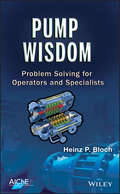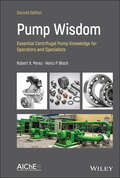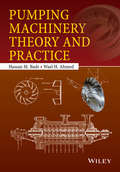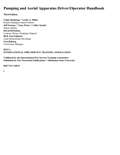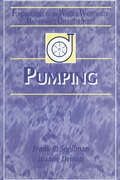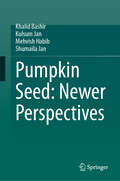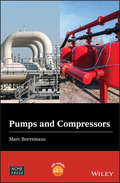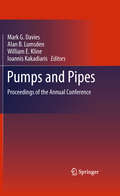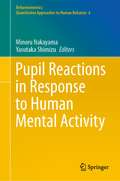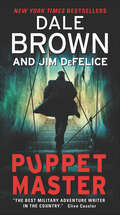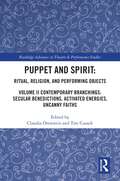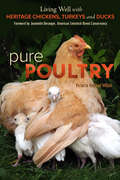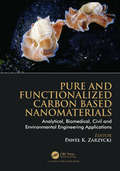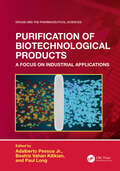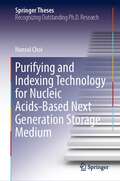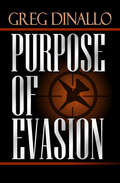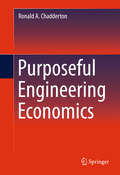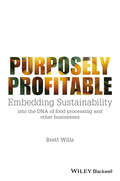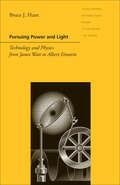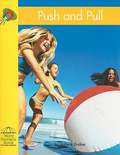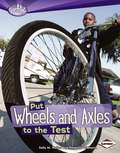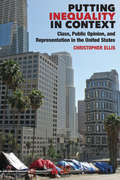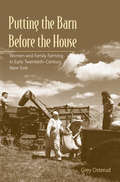- Table View
- List View
Pump Wisdom
by Heinz P. BlochLearn all the basics about pumps in one place. Clearly written by an ace consultant, this manual for operators and specialists in the petroleum industry gives readers a concise overview of the mechanics of various pumps and reviews the specifications to be considered before a pump is purchased and installed. The straight-forward text explains pump hydraulics without need of involved mathematics and provides expert advice on installing centrifugal pumps in process plants. The book also emphasizes the mechanical aspects of pumps as it delves into misunderstandings and oversights on bearings, seals, impeller trimming, lubricant application, lubricant types, and much more.
Pump Wisdom: Essential Centrifugal Pump Knowledge for Operators and Specialists
by Heinz P. Bloch Robert X. PerezExplore key facets of centrifugal pump ownership, installation, operation, and troubleshooting The Second Edition of Pump Wisdom: Essential Centrifugal Pump Knowledge for Operators and Specialists delivers a concise explanation of how pumps function, the design specifications that must be considered before purchasing a pump, and current best practices in lubrication and mechanical seals. Readers will encounter new startup and surveillance tips for pump operators, as well as additional repair and replace considerations for maintenance decision makers, new condition monitoring guidance for centrifugal pumps, and expanded coverage of operator best practices. This latest edition of Pump Wisdom includes expanded coverage of areas critical to achieving best-in-class pump reliability, including commonly encountered issues and easy-to-follow instructions for getting centrifugal pumps to operate safely and reliably. This book also provides: Comprehensible and accessible explanations of pump hydraulics Simple explorations of the mechanical aspects of pumps with coverage of bearings, seals, impeller trimming, lubricant application, and more Safety tips and instructions for centrifugal pumps Perfect for chemical, petroleum, and mechanical engineers, Pump Wisdom: Essential Centrifugal Pump Knowledge for Operators and Specialists is also an ideal resource for operators, managers, purchasing agents, machinists, reliability technicians, and maintenance workers in water and wastewater plants.
Pumping Machinery Theory and Practice
by Wael H. Ahmed Hassan M. BadrPumping Machinery Theory and Practice comprehensively covers the theoretical foundation and applications of pumping machinery. Key features:Covers characteristics of centrifugal pumps, axial flow pumps and displacement pumpsConsiders pumping machinery performance and operational-type problemsCovers advanced topics in pumping machinery including multiphase flow principles, and two and three-phase flow pumping systemsCovers different methods of flow rate control and relevance to machine efficiency and energy consumptionCovers different methods of flow rate control and relevance to machine efficiency and energy consumption
Pumping and Aerial Apparatus Driver/Operator Handbook
by Cynthia Brakhage Leslie A. Miller David DeStefano Jeff Fortney Tony Peters Libby Snyder International Fire Service Training Association StaffThe new editions of these bestselling IFSTA fire apparatus driver/operator training materials mark a new approach to training driver/operators. Previously, IFSTA published two separate manuals with student and instructor support materials: Pumping Apparatus Driver/Operator Handbook and Aerial Apparatus Driver/Operator Handbook. Fire departments with both types of apparatus needed two manuals, two curriculum and driver/operator trainees needed two exam preps to study for tests. The release of the 3rd edition of these manuals streamlines the IFSTA training resources.
Pumping: Fundamentals for the Water and Wastewater Maintenance Operator (Fundamentals for the Water and Wastewater Main Operator Series)
by Frank R. Spellman Joanne DrinanThis is the only book series devoted to explaining the full range of specialized areas required of water and wastewater plant operators. Each volume is designed to give operators the basic knowledge of a subject needed for certification, licensure, and improved job performance. Checkpoints, self-tests and a final examination with questions based on
Pumpkin Seed: Newer Perspectives
by Khalid Bashir Kulsum Jan Mehvish Habib Shumaila JanIncreased consumer awareness of the health benefits of foods has led food manufacturers to increasingly focus on the functional ingredients. The functional components found in pumpkin enhance immunity and provide a litany of health benefits for the consumer. Pumpkin is high in proteins, beneficial seed oils and antioxidant properties. Many different types of foods can be developed from pumpkin seed as well. To date there has been no reference work that documents the up-to-date knowledge regarding pumpkin seed its production, structure, health benefits and utilization to develop food products, plus the health benefits, bioavailability and accessibility. Pumpkin Seed: Newer Perspectives addresses the most recent advances and future prospects in pumpkin seed chemistry and valorization of pumpkin byproducts. The text provides researchers with a thorough understanding of new product development, use of protein in food supplementation, packaging films and many other uses. Different extraction techniques, phytochemical composition and applications in food and nutraceuticals are studied in full. Chapters deliver up-to-date information regarding the trends for the development of functional foods through pumpkin byproducts utilizing novel methods and updated technology, serving as a multidisciplinary source for researchers in food science and technology and biotechnology.
Pumps and Compressors (Wiley-ASME Press Series)
by Marc BorremansA practical guide to the majority of pumps and compressors used in engineering applications Pumps and compressors are ubiquitous in industry, used in manufacturing, processing and chemical plant, HVAC installations, aerospace propulsion systems, medical applications, and everywhere else where there is a need to pump liquids, or circulate or compress gasses. This well-illustrated handbook covers the basic function, performance, and applications for the most widely used pump and compressor types available on the market today. It explains how each device operates and includes the governing mathematics needed to calculate device performance such as flow rates and compression. Additionally, real-world issues such as cavitation, and priming are covered. Pumps & Compressors is divided into two sections, each of which offers a notation of variables and an introduction. The Pumps section covers piston pumps, radial turbopumps, axial turbopumps, rotating pumps, hydraulic pumps, and pumps with driving flow. The Compressors section covers piston compressors, rotating compressors, turbo compressors, ejectors, vacuum pumps, and compressors for cooling purposes. A virtual encyclopedia of all pumps and compressors that describes the mechanics of all devices and the theory, mathematics, and formulas governing their function Allows the reader to develop the skills needed to confidently select the appropriate pump or compressor type and specification for their applications Pumps & Compressors is an excellent text for courses on pumps and compressors, as well as a valuable reference for professional engineers and laymen seeking knowledge on the topic.
Pumps and Pipes
by Alan B. Lumsden Ioannis Kakadiaris Mark G. Davies William E. KlineThe Pumps and Pipes collaboration and conference brings together energy, medicine, and higher education in a unique shared effort, exploring ideas and research common to these important fields and stimulating discussion and sharing technologies that can further the reach and goals of each individual area. The Proceedings explores the common attributes of oil and gas technology, computational sciences and cardiovascular medicine and probe the areas where there is room to cross-fertilize and develop research and commercial programs.
Punched-Card Systems and the Early Information Explosion, 1880–1945 (Studies in Industry and Society)
by Lars HeideAt a time when Internet use is closely tracked and social networking sites supply data for targeted advertising, Lars Heide presents the first academic study of the invention that fueled today’s information revolution: the punched card. Early punched cards helped to process the United States census in 1890. They soon proved useful in calculating invoices and issuing pay slips. As demand for more sophisticated systems and reading machines increased in both the United States and Europe, punched cards served ever-larger data-processing purposes. Insurance companies, public utilities, businesses, and governments all used them to keep detailed records of their customers, competitors, employees, citizens, and enemies. The United States used punched-card registers in the late 1930s to pay roughly 21 million Americans their Social Security pensions, Vichy France used similar technologies in an attempt to mobilize an army against the occupying German forces, and the Germans in 1941 developed several punched-card registers to make the war effort—and surveillance of minorities—more effective. Heide’s analysis of these three major punched-card systems, as well as the impact of the invention on Great Britain, illustrates how different cultures collected personal and financial data and how they adapted to new technologies.This comparative study will interest students and scholars from a wide range of disciplines, including the history of technology, computer science, business history, and management and organizational studies.
Pupil Reactions in Response to Human Mental Activity (Behaviormetrics: Quantitative Approaches to Human Behavior #6)
by Minoru Nakayama Yasutaka ShimizuThis book focuses on a development for assessing mental changes using eye pupil reactions, namely extracting emotional change from the response to evaluate the viewer's interest in visual information. The pupil of the eye reacts to both brightness and emotional state, including interest, enjoyment, and mental workload. Because pupillary change is a biological signal, various artifacts influence measurements of eye images. Technical procedures are required to extract mental activities from pupillary changes, and they are summarized here step by step, although some procedures contain earlier techniques such as analog video processing. This study examines the possibility of estimating the viewer's interest and enjoyment of viewing movies by measuring the dynamic pupillary changes, blinking, and subjective interest responses. In evaluation of pupil size, there was a significant difference in pupil size between the higher and the lower shot for the degree of subject interest response in each kind of movies. The first part of the book shows a pupil reaction model for brightness changes to extract mental activities. Pupil reactions were observed for various visual stimuli in brightness changes. With regard to the characteristics of pupillary changes, a model with a three-layer neural network was developed and the performance was evaluated. Characteristics of pupil reactions during model development are summarized here. The second part examines the possibility of estimating the viewer's interest and enjoyment of television programs by measuring dynamic pupillary changes, blinking, and subjective interest responses. The final part describes a development of estimation model of pupil size for blink artifact. The model development was able to estimate pupillary changes and pupil size while the viewer was blinking and was applied to pupillary changes in viewing television programs.
Puppet Master (Puppetmaster #1)
by Dale Brown Jim DeFeliceNew York Times–Bestselling Authors: A roboticist aids the FBI in fighting Eastern European criminals using AI—until things go very wrong . . . Louis Massina is revolutionizing the field of robotics. His technological wonders are capable of locating disaster survivors, preventing nuclear meltdowns, and replacing missing limbs. After one of Massina’s creations makes a miraculous rescue, an FBI agent recruits him to pursue Russian mobsters running a massive financial scam—and not coincidentally, suspected of killing the agent’s brother. Massina agrees to deploy a surveillance bot that uses artificial intelligence to follow its target. But when he’s thrust into a dangerous conspiracy, the billionaire inventor decides to take matters into his own hands—unleashing the greatest cyberweapons in the world and becoming the Puppet Master . . . .Acclaim for Dale Brown“Authentic [and] riveting.” —San Francisco Chronicle“Gripping.” —New York Times
Puppet and Spirit: Volume II Contemporary Branchings: Secular Benedictions, Activated Energies, Uncanny Faiths (ISSN)
by Claudia Orenstein Tim CusackThis anthology of essays, a companion to Puppet and Spirit: Ritual, Religion, and Performing Objects, Volume I, aims to explore the many types of relationships that exist between puppets, broadly speaking, and the immaterial world.The allure of the puppet goes beyond its material presence as, historically and throughout the globe, many uses of puppets and related objects have expressed and capitalized on their posited connections to other realms or ability to serve as vessels or conduits for immaterial presence. The flip side of the puppet’s troubling uncanniness is precisely the possibilities it represents for connecting to discarnate realities. Where do we see such connections in contemporary artistic work in various mediums? How do puppets open avenues for discussion in a world that seems to be increasingly polarized around religious values? How do we describe, analyze, and theorize the present moment? What new questions do puppets address for our times, and how does the puppet’s continued entanglement with these concerns trouble or comfort us? The essays in this book, from scholars and practitioners, provide a range of useful models and critical vocabularies for addressing this aspect of puppet performance, further expanding the growing understanding and appreciation of puppetry generally.This book, along with its companion volume, offers, for the first time, robust coverage of this subject from a diversity of voices, examples, and perspectives.
Pure Poultry
by Victoria Redhed MillerPure Poultry is a timely resource for new and experienced poultry keepers who want to raise heritage breeds as an integral part of a more sustainable food system. This inspiring "how-to and why-to" guide combines revealing and often humorous anecdotes with detailed information on everything from housing, breeding and day-to-day care, to cooking and food preservation.
Pure and Functionalized Carbon Based Nanomaterials: Analytical, Biomedical, Civil and Environmental Engineering Applications
by Paweł K. ZarzyckiThis book describes in a comprehensive manner latest studies conducted by various research groups worldwide focusing on carbon and related nanomaterials. Fourteen chapters of this book deal with a number of key research topics and applications of pure and functionalized carbon nanomaterials and their hybrid nanocomposites. Specifically, the authors have presented interdisciplinary investigations including: (i) carbon nanoparticles and layers synthesis, (ii) analytical aspects of carbon nanomaterials and their characterisation under different conditions as well as (iii) various applications of carbon nanoparticles. They have reported and summarised key applications of carbon particles or nanoobjects in pharmacy, biomedicine, agriculture and food industry, water treatment, physicochemical analysis, optoelectronics, electronic and magnetic materials for supercapacitors or radar adsorbing materials, tribology, chromatography, electrophoresis, bioanalysis, nanobiocatalysis, biofuels production as well as environmental remediation.
Purification of Biotechnological Products: A Focus on Industrial Applications (ISSN)
by Paul Long Pessoa Jr. Adalberto Beatriz Vahan KilikianThis outstanding text focuses on providing professionals and students working in the pharmaceutical and biotechnology field with the background necessary for developing of a product or process and with the necessary rigor required by federal regulatory agencies in the pharmaceutical industry. The material will enable teachers, lecturers and professors in biotechnology to prepare courses on basic concepts and applications for the purification of biotechnological products of industrial interest. These can be applied in practice, for example, with projects on purification development on an industrial scale or useful unit operations for the development of bioproducts of commercial interest.Features: Purification and development of new bioproducts and improvement of those being produced. Provides a background and concepts on the purification of biomolecules and with an industrial perspective. It allows professionals to understand the entire process of developing a biopharmaceutical or bio-food, from bench to industry in biotechnology; one of the fastest-growing sectors of the economy. It promotes the dissemination of information in a didactic way which is of paramount importance for interdisciplinary fields It enables the reader to follow step-by-step stages of the development of a new biopharmaceutical, and allows the optimization of existing processes.
Purifying and Indexing Technology for Nucleic Acids-Based Next Generation Storage Medium (Springer Theses)
by Hansol ChoiThis book introduces novel purification technology for the complex oligonucleotide libraries. Since the concept of synthesizing oligonucleotides (oligos) has been proposed, research fields such as nucleic acid-based therapies (CRISPR-Cas9, DNA/RNA vaccines, RNAi), synthetic biology, protein engineering, and DNA-based data storage have bloomed. The COVID-19 pandemic underscores the potential of nucleic acid-based technologies, such as vaccines or diagnostics. As they emerge as the most promising weapons against the current pandemic, increasing need for highly accessible nucleic acid purification technologies is expected. To meet this demand, an oligo purification technology that can be applied to complex oligo libraries and can purify oligos with single-base resolution is developed. In addition, the purification technology can be applied to highly complex oligo libraries of different lengths, enabling the simultaneous purification of complex oligo libraries with different lengths. The proposed technology can be easily accessed by users and would help accelerate numerous research fields that utilize oligos as fundamental building blocks.
Purpose of Evasion
by Greg DinalloGreg Dinallo&’s blockbuster Rockets&’ Red Glare earned rave reviews for its ingenious use of the Cuban Missile Crisis and detailed knowledge of current military technology. Now, with Purpose of Evasion, Dinallo proves he&’s a master of the techno-thriller genre. Seven Americans languish in captivity somewhere in the Middle East. Soon they will begin to die. In desperation, CIA Director Bill Kiley authorizes the shadowy air force colonel Richard Larkin to carry out a shocking plan: Under the cover of a punitive air raid on Libya, Larkin will deliver two highly sophisticated F-111 bombers to Libyan dictator Muammar el-Qaddafi. The reason? Qaddafi claims that he knows where the hostages are and that he can deliver them safely into American hands. The catch? Larkin must kill two American pilots to make the plan work. In Beirut, a brilliant and handsome Saudi named Saddam Moncrieff, secretly working for the CIA, arranges a meeting with an old lover. She is Katifa, passionate, flawlessly beautiful, and completely committed to the vicious Palestinian terrorist Abu Nidal, who had hidden the hostages somewhere in the Middle East. For the sake of the hostages, Moncrieff must somehow turn Katifa against her master. As Larkin&’s cynical plot is executed, he makes one crucial mistake: Major Walter Shepherd, one of the American pilots marked for death, escapes. As long as Shepherd lives, the operation can be exposed. Kiley and Larkin make a decision: Shepherd must be found—and killed. A team of assassins is dispatched to locate and terminate the fiercely independent air force pilot. Shepherd sets out on a heart-stopping journey to save his honor and his life—unaware that, at the very same moment, a crack navy SEAL team has been sent on a mission to rescue the hostages. The tension mounts to unbearable levels as Nidal&’s deadline for killing the hostages draws near, and Shepherd finds himself caught in the violent madness that is the Middle East.Purpose of Evasion is a stunning triumph, an eerily plausible &“what if?&” techno-thriller set in a world where deception is a way of life and death haunts every moment.
Purposeful Engineering Economics
by Ronald A. ChaddertonPurposeful Engineering Economics stands as a unique and highly original complement to the traditional engineering economics curriculum. This primarily narrative text conveys the essence of an "Austrian" economic perspective on cash flow analysis and decision making in engineering without extensive tables and graphs and requires very little mathematics. The book's objective is to add a new perspective to the usual study of cash flow analysis and solely econometric engineering decision making. The author draws on the methodology of the Austrian Economists--a school of economic thought that bases its study of economic phenomena on the interpretation and analysis of the purposeful actions of individuals. The book includes an array of illustrative case studies examined in detail by the author and emphasizes the importance of market processes and price signals to coordinate engineering plans.
Purposely Profitable
by Brett WillsCompeting and winning in today?s competitive marketplace requires a strategy that includes sustainability. Business leaders who embrace it and convey a strong sense of purpose behind their strategy are propelling their organizations into revenue-increasing, cost-reducing outcomes. Purposely Profitable: Embedding Sustainability into the DNA of Food Processing and other Businesses provides a proven, step-by-step methodology for integrating sustainability into the strategic plan to develop a strategy that is sustainable and aligned to a greater purpose. This book notably includes the following: A primer on Sustainability that defines Sustainable Business and presents the Business Case for Sustainability What is an organizational purpose and why is it so important in today?s competitive marketplace Step by step instructions, supported by a case study, for developing each component of the strategic plan (Purpose, Vision, Strategic Pillars, KPI?s, Goals, Programs Action Plans, and Tactical Execution) A suite of tools and resources to support the development and execution of the strategic plan Scientists and managers in the global food supply chain, sustainability professionals, researchers, students, regulators, executives and business owners will come to learn and understand a powerful system for developing a strategy that is sustainable in order to maximize organizational performance.
Pursuing Power and Light: Technology and Physics from James Watt to Albert Einstein (Johns Hopkins Introductory Studies in the History of Science)
by Bruce J. HuntIn the nineteenth century, science and technology developed a close and continuing relationship. The most important advancements in physics—the science of energy and the theory of the electromagnetic field—were deeply rooted in the new technologies of the steam engine, the telegraph, and electric power and light. Bruce J. Hunt here explores how the leading technologies of the industrial age helped reshape modern physics.This period marked a watershed in how human beings exerted power over the world around them. Sweeping changes in manufacturing, transportation, and communications transformed the economy, society, and daily life in ways never before imagined. At the same time, physical scientists made great strides in the study of energy, atoms, and electromagnetism. Hunt shows how technology informed science and vice versa, examining the interaction between steam technology and the formulation of the laws of thermodynamics, for example, and that between telegraphy and the rise of electrical science.Hunt’s groundbreaking introduction to the history of physics points to the shift to atomic and quantum physics. It closes with a brief look at Albert Einstein’s work at the Swiss patent office and the part it played in his formulation of relativity theory. Hunt translates his often-demanding material into engaging and accessible language suitable for undergraduate students of the history of science and technology.
Push and Pull
by Hollie J. EndresYoung readers can find out more about how different objects can be pushed and pulled, and the scientific forces behind motion.
Put Wheels and Axles to the Test (Searchlight Books: How Do Simple Machines Work?)
by Sally M. Walker Roseann FeldmannThe book presents information about what wheels and axles are and how they help people to do work more easily, and suggests ways for readers to use common items to experience for themselves how these simple machines work.
Putting Inequality in Context: Class, Public Opinion, and Representation in the United States
by Christopher EllisRising income inequality is highlighted as one of the largest challenges facing the United States, affecting civic participation and political representation. Although the wealthy often can and do exert more political influence, this is not always the case. To fix political inequality, it is important to understand exactly how class divisions manifest themselves in political outcomes, and what factors serve to enhance, or depress, inequalities in political voice. Christopher Ellis argues citizens’—and legislators’—views of class politics are driven by lived experience in particular communities. While some experience is formally political, on an informal basis citizens learn a great deal about their position in the broader socioeconomic spectrum and the social norms governing how class intersects with day-to-day life. These factors are important for policymakers, since most legislators do not represent “the public” at large, but specific constituencies. Focusing on U.S. congressional districts as the contextual unit of interest, Ellis argues individuals’ political behavior cannot be separated from their environment, and shows how income’s role in political processes is affected by the contexts in which citizens and legislators interact. Political inequality exists in the aggregate, but it does not exist everywhere. It is, rather, a function of specific arrangements that depress the political influence of the poor. Identifying and understanding these factors is a crucial step in thinking about what reforms might be especially helpful in enhancing equality of political voice.
Putting Social Movements in Their Place
by Doug Mcadam Hilary Schaffer BoudetThe field of social movement studies has expanded dramatically over the past three decades. But as it has done so, its focus has become increasingly narrow and 'movement-centric'. When combined with the tendency to select successful struggles for study, the conceptual and methodological conventions of the field conduce to a decidedly Ptolemaic view of social movements: one that exaggerates the frequency and causal significance of movements as a form of politics. This book reports the results of a comparative study, not of movements, but of communities earmarked for environmentally risky energy projects. In stark contrast to the central thrust of the social movement literature, the authors find that the overall level of emergent opposition to the projects has been very low, and they seek to explain that variation and the impact, if any, it had on the ultimate fate of the proposed projects.
Putting the Barn Before the House: Women and Family Farming in Early Twentieth-Century New York
by Grey OsterudPutting the Barn Before the House features the voices and viewpoints of women born before World War I who lived on family farms in south-central New York. As she did in her previous book, Bonds of Community, for an earlier period in history, Grey Osterud explores the flexible and varied ways that families shared labor and highlights the strategies of mutuality that women adopted to ensure they had a say in family decision making. Sharing and exchanging work also linked neighboring households and knit the community together. Indeed, the culture of cooperation that women espoused laid the basis for the formation of cooperatives that enabled these dairy farmers to contest the power of agribusiness and obtain better returns for their labor. Osterud recounts this story through the words of the women and men who lived it and carefully explores their views about gender, labor, and power, which offered an alternative to the ideas that prevailed in American society. Most women saw "putting the barn before the house"-investing capital and labor in productive operations rather than spending money on consumer goods or devoting time to mere housework-as a necessary and rational course for families who were determined to make a living on the land and, if possible, to pass on viable farms to the next generation. Some women preferred working outdoors to what seemed to them the thankless tasks of urban housewives, while others worked off the farm to support the family. Husbands and wives, as well as parents and children, debated what was best and negotiated over how to allocate their limited labor and capital and plan for an uncertain future. Osterud tells the story of an agricultural community in transition amid an industrializing age with care and skill.
